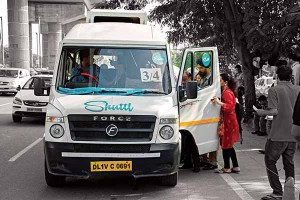Aggregators in India’s transportation industry are growing up to be a force to reckon with.
Team CV
In the Oxford Dictionary, the word aggregator is defined as a website or program that collects related items of content and displays them or links to them. In India, the word aggregator has come to be associated with radio taxi operators like Ola, Uber, SheTaxi, Apnacabs, Baxi and AutonCabs; shuttle bus operators like Shuttl, Cityflo and Zipgo, and on-demand transport companies like Quikhop, Rivigo, Trukky, Shiprocket, LetsTransport, ThePorter, Blackbuck, Truckola, 4TiGo and TruckMandi. Looked upon as a disruptive force in the US$ 300 billion transportation industry in India, these aggregators are technology driven. Leveraging cloud computing and Internet of Things (IoT) to help transporters and service providers to scale up their business for a fee or a commission; to enable clients and commuters to avail of a superior experience, aggregators are displaying the capability to dismantle malpractices and loopholes. Coming to play a significant role in the country’s mobility space, aggregators have moved beyond the start up phase. It is a different story that their success is fuelling startups.
Set to gain from the GST council’s decision to lower taxes, cab aggregators, according to a survey report by Morgan Stanley, have much scope to grow. The report mentions that more than half of the millennials in India have not used an app-based cab service yet. The usage of cab-aggregator services, the survey report claims, has led to a mere three per cent of the millennials giving up their cars. A small fraction of the people surveyed mentioned that they are availing of cab aggregator service to avoid the rush and deficiencies that public transport mediums like buses, local trains and even metros offer. If Women on Wheels and SheTaxi make an innovative aggregator model on the back of social and economic empowerment of women, bus aggregators like Shuttl and Cityflo are making travel to work easy and stress free. Providing AC buses with assured seats without having to pay big bucks for fuel and shared cabs, bus aggregators are helping commuters to travel without cash. Commuters can also reserve as well as real-time track the seats. Providing a clue about the growth potential of bus aggregators, Jaspal Singh, Analyst, Valoriser Consultants, avers, “Even if 10 per cent of the commuter volume shifts towards bus aggregating platform, it will amount to a big number for the industry.” He draws attention to over 30 million bus rides taking place in India everyday. The demand for mobility is rising, and the government is required to support new disruptive initiatives the aggregators are taking, opines an industry source.
An interesting aggregator in the inter-city travel space is Redbus. It is claimed to be the biggest bus service aggregator in India, and commands a 75 per cent market share of online bus booking. With the overall size of bus ticketing industry in India (both offline and online) estimated to be about 20,000 crores worth, about 14 per cent of the tickets are known to be sold online. Approximately 10 per cent of the bus operators are said to have a fleet size greater than 75 each, and 25 per cent of the bus operators are claimed to have a fleet size between 20 to 75 buses each. If challenges exist in retaining customers by ensuring a superior travel experience, much of which could be out of the control of the aggregator, and to help bus operators to scale up their business, there is no smooth road to success that the aggregators could look at. With government agencies beginning to acknowledge the benefits, the aggregator bus and cab services have come to provide, what was once perceived as the biggest challenge is now ebbing. Other challenges include standardised fare structure, quality of service, and an ability to integrate with other services.
With the government’s stress on cashless transaction, aggregators stand to gain, albeit with a steady rise of e-commerce and on-demand services. Playing a key role in bringing structure and equilibrium within the organised space across various industries, aggregators in the logistics space, claims an industry source, are helping to lose unnecessary weight in terms of structure and costs. Attracting seeding on the basis of an innovative approach, aggregators like Trukky, Lobb and Blackbuck are providing not just fringe benefits to truckers, they are also matching and optimising the demand and supply of trucks. Says Apollo Sharma, CEO, Quikhop Logitic Solutions, “Our algorithms have integrated solutions for return trucks that are available at a cost that are cheaper than the origin city trucks for resource management.”
With aggregator startups like TruckMandi, Trucksumo and Sastabhada folding up on account of logistics sector fragmenting, and the brick and mortar business posing a big challenge, it has become essential for aggregators to take a full stack view of the space they want to be a part of. The Indian logistics space is complex, mentions an industry expert. He states that it is so complex that it can demand attention, which technology simply cannot help overcome. Mukul Arora, Managing Director, SAIF Partners, is known to have expressed that adding a thin layer of technology cannot solve deep routed problems in the logistics sector such as non-availability of drivers and fragmented truck ownership. The demand for credit that often extends beyond is also a factor. Looking at the challenges faced by TruckMandi, Trucksumo and Sastabhada, it is clear that knowledge and experience will only add to the sustainability of aggregators. Set to witness greater adoption among numerous market players, aggregators have a long way to go before success is theirs. The path is challenging, but also exciting and well worth the effort.
























